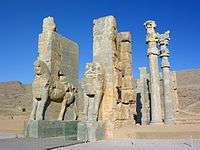Salghurids
| Salghurids | ||||||||||
| سلغُریان | ||||||||||
| ||||||||||
 | ||||||||||
| Capital | Shiraz | |||||||||
| Languages | Persian Turkic | |||||||||
| Religion | Sunni Islam | |||||||||
| Government | Monarchy | |||||||||
| Atabeg | ||||||||||
| • | 1148–1161 | Sunqur ibn Mawdud | ||||||||
| • | 1264–1282 | Abish Khatun | ||||||||
| Historical era | Middle Ages | |||||||||
| • | Established | 1148 | ||||||||
| • | Disestablished | 1282 | ||||||||
| ||||||||||
| Pre-14th century | |||||||
|---|---|---|---|---|---|---|---|
| Turkic Khaganate 552–744 | |||||||
| Western Turkic | |||||||
| Eastern Turkic | |||||||
| Khazar Khaganate 618–1048 | |||||||
| Xueyantuo 628–646 | |||||||
| Great Bulgaria 632–668 | |||||||
| Danube Bulgaria | |||||||
| Volga Bulgaria | |||||||
| Kangar union 659–750 | |||||||
| Turgesh Khaganate 699–766 | |||||||
| Uyghur Khaganate 744–840 | |||||||
| Karluk Yabgu State 756–940 | |||||||
| Kara-Khanid Khanate 840–1212 | |||||||
| Western Kara-Khanid | |||||||
| Eastern Kara-Khanid | |||||||
| Gansu Uyghur Kingdom 848–1036 | |||||||
| Kingdom of Qocho 856–1335 | |||||||
| Pecheneg Khanates 860–1091 |
Kimek Khanate 743–1035 | ||||||
| Cumania 1067–1239 |
Oghuz Yabgu State 750–1055 | ||||||
| Ghaznavid Empire 963–1186 | |||||||
| Seljuk Empire 1037–1194 | |||||||
| Seljuk Sultanate of Rum | |||||||
| Kerait khanate 11th century–13th century | |||||||
| Khwarazmian Empire 1077–1231 | |||||||
| Naiman Khanate –1204 | |||||||
| Qarlughid Kingdom 1224–1266 | |||||||
| Delhi Sultanate 1206–1526 | |||||||
| Mamluk dynasty | |||||||
| Khilji dynasty | |||||||
| Tughlaq dynasty | |||||||
| Golden Horde | [1][2][3] 1240s–1502 | |||||||
| Mamluk Sultanate (Cairo) 1250–1517 | |||||||
| Bahri dynasty | |||||||
| Ottoman Empire 1299-1923 | |||||||
|
Other Turkic dynasties
in Anatolia | |||||||
The Salghurids of Fars (Persian: اتابکان فارس 'Atābakān-e Fārs' or سلغُریان 'Salghoriān'), were a dynasty of Turkmen origin[4] that ruled Fars, first as vassals of the Seljuqs then for the Khwarazm Shahs in the 13th century. The Salghurids were established by Sunqur in 1148, who had profited from the rebellions during the reign of Seljuq sultan Mas'ud b. Muhammad. Later the Salghurids were able to solidify their position in southern Persia to the point of campaigning against Kurds and involving themselves in the succession of the Kirman Seljuqs,[5] holding Seljuq sultan Malik-Shah III's son Mahmud as a possible claimant to the Seljuq throne.[6] They captured Isfahan in 1203-4,[7] and later occupied Bahrain taken from the Uyunid dynasty in 1235.[8]
Under Sa'd I b. Zangi, the Salghurids experienced a significant prosperity, which was marred by his acknowledging the Khwarazm Shahs as his overlord. Saadi Shirazi, the Persian poet, dedicated his Bostan and Gulistan to Sa'd I and Sa'd II.[9] Following Sa'd I's death, his brother Zangi b. Mawdud took power in 1161. Dekele/Tekele followed his father, Zangi, only after eliminating Sonqur's son Toghril.[10]
During the 13th century, the Salghurids patronized a cultural and intellectual atmosphere which included, Kadi al-Baydawi, Qutb al-Din al-Shirazi, Saadi Shirazi and the historian Wassaf.[11]
During the closing years of Aku Bakr and Sa'd II, Fars fell under the dominion of Mongol empire and later the Ilkhanate of Hulegu. Under the Mongols, Abu Bakr was given the title of Qutlugh Khan. Later Salghurids were powerless figureheads, until the daughter of Sa'd II, Abish Khatun was given the title of Atabegate of Fars. She was the sole ruler of Fars for one year whereupon she married, Mengu Temur, eleventh son of Hulegu.[12] Following their deaths, Fars was ruled directly by the Ilkhanate.[13]
List of Atabegs
- Sunqur b. Mawdud (1148–1161)
- Zangi b. Mawdud (1161–1178)
- Degele/Tekele b. Zangi (1178–1198)
- Sa'd I b. Zangi (1198–1226)
- Qutlugh Khan Abu Bakr b. Sa'd I (1226–1260)
- Sa'd II b. Qutlugh Khan (1260–1262)
- Muhammad Shah b. Salghur Shah b. Sa'd I (1262–1263)
- Seljuq Shah b. Salghur Shah (1263)
- Abish Khatun b. Sa'd II (1263)
- Abish Khatun w/ Mengu Temur b. Hulegu (1264–1282)
See also
References
- ↑ Marshall Cavendish Corporation (2006). Peoples of Western Asia. p. 364.
- ↑ Bosworth, Clifford Edmund (2007). Historic Cities of the Islamic World. p. 280.
- ↑ Borrero, Mauricio (2009). Russia: A Reference Guide from the Renaissance to the Present. p. 162.
- ↑ Salghurids, C.E. Bosworth, The Encyclopaedia of Islam, Vol. VIII, ed. C.E.Bosworth, E. van Donzel, W.P. Heinrichs and G. Lecomte, (E.J.Brill, 1995), 978;"SALGHURIDS, a line of Atabegs which ruled in Pars during the second half of the 12th century and for much of the 13th one (1148-1282). They were of Turkmen origin.."
- ↑ C.E. Bosworth, The New Islamic Dynasties, (Columbia University Press, 1996), 207.
- ↑ The Political and Dynastic History of the Iranian World, C.E. Bosworth, The Cambridge History of Iran, Vol. 5, ed. John Andrew Boyle, (Cambridge University Press, 1968), 169.
- ↑ Salghurids, C.E. Bosworth, The Encyclopaedia of Islam, Vol. VIII, 978.
- ↑ Curtis E. Larsen, Life and Land Use on the Bahrain Islands: The Geoarchaeology of an Ancient Society, (University of Chicago Press, 1984), 66.
- ↑ C.E. Bosworth, The New Islamic Dynasties, 207.
- ↑ Salghurids, C.E. Bosworth, The Encyclopaedia of Islam, Vol. VIII, 978.
- ↑ Salghurids, C.E. Bosworth, The Encyclopaedia of Islam, Vol. VIII, 979.
- ↑ Salghurids, C.E. Bosworth, The Encyclopaedia of Islam, Vol. VIII, 979.
- ↑ C.E. Bosworth, The New Islamic Dynasties, 207.
